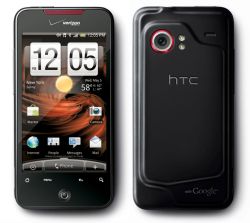Reviews are starting to pop up for Verizon’s new star. While much of it’s hardware is similar to Nexus one or the as yet unreleased HTC Evo, there are some notable differences that make Incredible stand out. Â If you’ve forgotten what Droid Incredible is packing, you can find that here. Speaking of which, let’s get to the overall impressions.
The case:
The Incredible might be the world’s first mullet phone: flat, straightforward business in the front, stylized rubber party in the back. In fact, if you pop the back condom off (it’s got ridges and it’s rubber, it’s basically a hard condom), the Incredible’s hot-rod red underneath. It saves the phone from verging into boring-as-hell territory. Slightly thicker than a Nexus One or iPhone, but lighter, it feels (and looks) chintzier than both.
The buttons:
Four capacitive buttons (meaning there’s not actually anything to press down) rest just below the touchscreen, arranged in HTC’s standard home-menu-back-search layout. Below the capacitive buttons is a small “optical joystick” (it’s not actually a trackpad as found on the new BlackBerries) that’s ringed by a button — the only thing that actually moves on the front of the device.
Like with the HTC Desire and Legend, this “optical joystick”-button combination is much more stylish than the outdated trackball that you can find on the T-Mobile G1 — the very first Android smartphone — as well as on the Google Nexus One. It allows for a much more continuous design while providing acute selections — meaning you’ll likely only use it when moving a cursor a space or two and when selecting text to copy and paste. (Outside of that, we could well live without it.)
The display:
In general, the Incredible’s display was very reminiscent of the Nexus One screen — that should come as no surprise, they’re identical — though the touch response seemed notably better here, likely a software issue. Because these displays are the same, it means they share the same issues; we disliked the color intensity on the Incredible just as we did on the Nexus One. Reds and oranges, in particularly, look overwhelmingly saturated here, and other colors aren’t truly represented. It’s just too colorful, if you can believe it.
The Sense UI:
The Incredible features the latest version of HTC Sense, with its distinctive large flip clock and weather info front and center. It’s the same in look and feel as we saw on the HTC Desire.  If you’re new to Sense (or Android), think of it as a custom skin on top of Android that makes your smartphone experience easier, more attractive and more enjoyable.
Some of the highlights of Sense include:
- Footprints: A photo geotagging (location) app and widget.
- Friend Stream: Bringing Twitter, Facebook and Flickr all under one roof.
- Peep: HTC’s own Twitter client.
- Weather: HTC is famous for its weather app and widget, and it’s included here as well.
And a special note about the screens:
Sense also brings you an almost silly number of home screens. Where the Droid only has three and the Nexus One has five, Sense cranks things up to seven. And that’s just for starters. You also have seven “scenes” — preloaded groups of seven home screens — from which to choose, and you can save your own custom scenes as well. That means you can have one scene for workdays, with calendar widgets and e-mail widgets and all the bells and whistles that keep you functioning. And with a couple of simple taps, you can leave all that behind with a different scene, say, one that has HTC’s custom music player, Friend Stream to see what your pals are up to, and a text message widget so you don’t miss a beat.
The verdict:
Let’s just put this out there: the Droid Incredible is the best Android device that you can purchase in America right now. It’s better than the Droid, better than the Nexus One, and certainly beats the pants off of any previous generation handsets like the Eris, myTouch, or Cliq. It’s not just a very, very good Android phone (though it is); it’s also an excellent smartphone no matter how you cut it.
You can find the full reviews at Android Central, Gizmodo, and Engadget
[Source Android Central, Gizmodo, Engadget]










